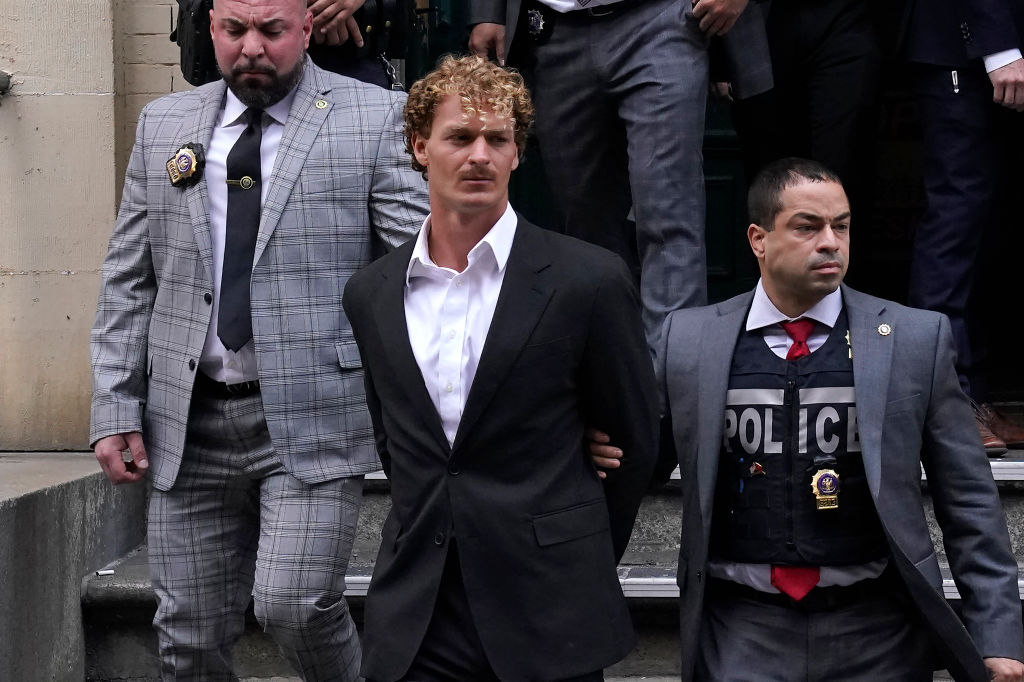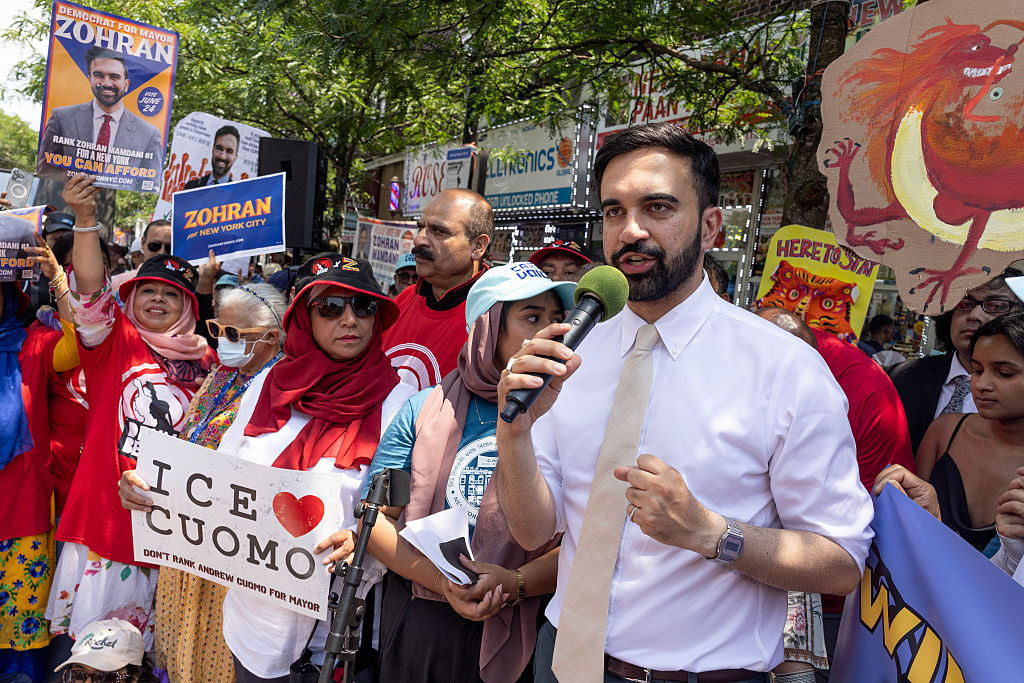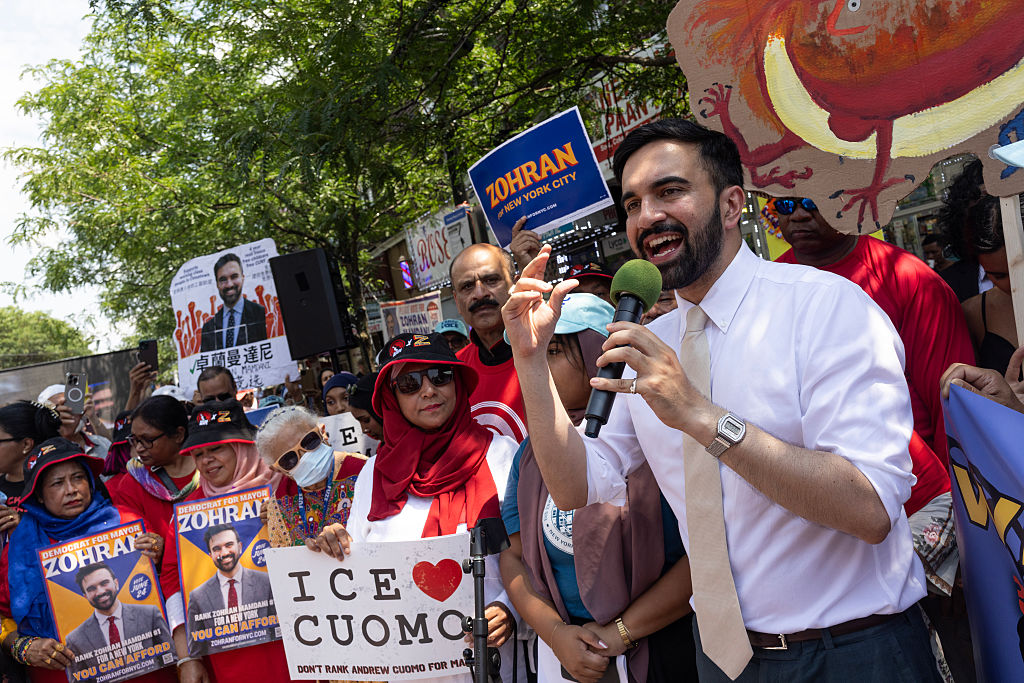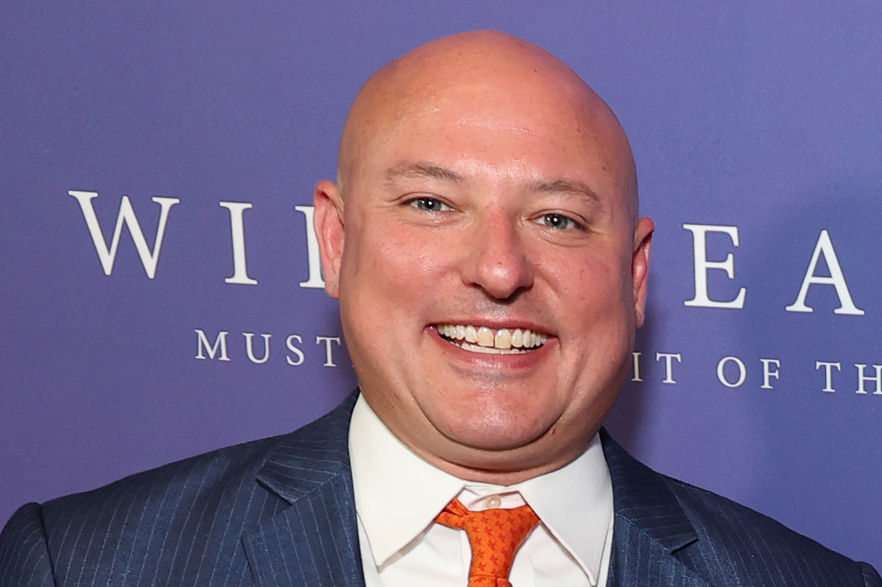Jordan Neely was given a hero’s funeral in Harlem last Friday, eulogized by New York’s most prominent race activists before an audience of the city’s Democratic elite. Neely died on May 1 on a New York City subway car, after being restrained by a Marine veteran who was trying to protect his fellow passengers from Neely’s psychotic outbursts.
Neely has been turned into a symbol of a racist system of law enforcement and of civilian values that exaggerate the threat of mentally ill vagrants to keep minorities down. Three weeks after Neely’s death, on May 21, another homeless man in New York City slammed a woman’s head into a subway car, likely paralyzing her for life, if she even survives. Neely’s champions have been silent about this latest subway assault.
All the pathologies afflicting American cities were present in that earlier fatal encounter and its aftermath: the grotesque parody of compassion that is conventional homeless policy; government’s elevation of the supposed interests of the anti-social and dysfunctional over those of the law-abiding and hard-working; anti-white race-baiting and racial bathos.
But the May 1 confrontation between the ex-Marine Daniel Penny and the mentally ill Neely stands for more than failed policy. Reaction to Penny’s intervention illuminates as well the war on manly virtues and their attempted replacement with an emasculated dependence on bureaucrats and social workers.
Jordan Neely was a standard product of New York’s homelessness empire. A thirty-year-old schizophrenic drug addict, Neely had cut a swathe of destruction and fear through New York’s streets and subways for fifteen years. Despite his predilection for assaulting the elderly, he had been repeatedly allowed to skip out of treatment and jail. In 2019, Neely punched Filemon Castillo Baltazar in the head as the sixty-five-year-old waited for a subway in Greenwich Village. In June 2021, he walloped Anne Mitcheltree in the head inside a deli in the East Village; she was in her late sixties. In November 2021, Neely broke the nose and fractured the eye socket of a sixty-seven-year-old woman as she exited a subway on the Lower East Side.
These physical assaults were accompanied by a steady stream of disturbing behavior. In June 2019, for example, Neely banged on the door of a subway ticket agent’s booth and threatened to kill her.
None of these attacks landed Neely in long-term mental health confinement, even though, as a mentally ill chemical abuser (MICA), Neely was certain to attack again. Drug use sharply increases violence in the mentally ill, but Neely’s heavy use of the synthetic marijuana K-2 should have been particularly worrying to his social worker contacts. Due to its strength and powerful psychological effects, K-2 was even more likely to trigger violent outbreaks. No matter. His forty-two arrests produced at best brief jail stints and his hundreds of encounters with outreach workers always left him free to return to the streets.
It was not as if he had no alternatives. For decades, New York taxpayers have been obligated to pay for shelter on demand for anyone who claims homelessness. This annual multi-billion-dollar mandate comes courtesy of an activist judge who in 1981 declared such shelter a constitutional right. Single mothers get private apartments; adults without children in tow are guaranteed a shelter bed. If a sheltered vagrant accepts services, he too will become eligible for permanent subsidized housing.
But here is the brilliance of the system from a homeless advocate’s point of view: while vagrants have a right to shelter, they have no obligation to use it. They are free to continue colonizing public and private spaces if they prefer. Taxpayers, meanwhile, have no choice in whether they pay for the scorned shelter; it must always be available to the finicky homeless, whether it is accepted or not. Conferring such choice on street colonizers guarantees that the street population will remain “unhoused,” since the vast majority of that population prefers the street lifestyle of uninhibited drug use and bounteous handouts to even the most nonjudgmental, anything-goes shelter. And, most critically, that unhoused population provides lifetime employment for government bureaucrats and private social service providers.
An army of feckless “outreach workers” pads around after the vagrants, politely inquiring as to whether this time, they might deign to accept services and shelter. They almost always don’t. Neely was an inaugural member of the Top Fifty list, consisting of New York’s most intractable vagrants. The list, created in 2019, is monitored by a body known as the Coordinated Behavioral Health Task Force, with representatives from the city Departments of Health, of Homeless Services, and of Hospitals, as well as representatives from the archipelago of city-subsidized nonprofits. An encounter between task force members and Neely on April 8, 2023, shows just how ineffective this intergovernmental body is. Several outreach workers had come across Neely in a subway car at Coney Island, flashing his genitals and urinating on the floor. (April 8, in other words, was just another typical day in the city’s subway system.)
Neely had been AWOL since March from a treatment program to which he had been assigned after the November 2021 skull-bashing. There was a warrant out for his arrest, a particularly futile gesture since outreach workers don’t check for warrants as a philosophical matter and the police don’t either, since that would be “criminalizing homelessness.” Therefore, though the outreach workers had summoned the police to respond to Neely’s disorderly conduct, the officers simply let him go, having failed to discover the open warrant and ignoring his other infractions against public order.
One of the case worker’s follow-up notes embodies the system’s willed passivity: “Due to client’s [i.e., Neely’s] aggressive behavior, he could be a harm to others or himself if left untreated and not assessed by a mental health professional.” And yet leave Neely untreated is exactly what the case workers did. (The ubiquitous label “client” for vagrants is one of many fanciful aspects of the homelessness charade, treating a drug-addled lunatic as having the capacity to enter into a professional agency relationship.)
So it was that this walking time bomb got on the F line at the Lafayette and Broadway station in Manhattan’s SoHo, threw his jacket on the floor, and screamed that he was hungry, thirsty, and willing to die. One police source has reported that Neely was throwing things at passengers. The “freelance journalist,” as the press identifies him, who filmed the next steps in the incident has given several versions of Neely’s rant. “I don’t mind going to jail and getting life in prison. I’m ready to die,” goes one version. “I’m tired already. I don’t care if I go to jail and get locked up. I’m ready to die,” goes another. The Daily Mail reports a third version from another eyewitness: “I would kill a motherf***er. I don’t care. I’ll take a bullet. I’ll go to jail.”
Whatever the exact phraseology, the current claim that this tirade is anything but a clear warning signal of potential violence is absurd. Untreated MICA vagrants have been pushing people under and into subway trains for years, besides beating up on pedestrians and subway passengers. Neely’s echo of the “death by cop” gambit, whereby the mentally ill try to goad police officers into shooting them, was particularly ominous.
Most of the passengers on Neely’s car tried to get away from him, rightly believing that he posed a patent threat. Daniel Penny, however, put his arms around Neely from behind and took him down. At this point, the video begins. As Penny lay on the ground with a thrashing Neely on top of him, another man tried to grab hold of Neely’s wrists (demonstrating the difficulty of cuffing a resisting suspect, a reality always overlooked by the anti-police press).
Penny and his fellow Good Samaritan held Neely down for several minutes and then rolled him over on his side in a recovery position. The video does not suggest that Neely was in a chokehold during that entire time. (A chokehold applies pressure to the carotid arteries in the neck to induce temporary unconsciousness.) Rather, Penny appears to be restraining Neely with a bear hug until the police can arrive.
New York’s medical examiner ruled that Neely died from compression of the neck. But because Neely’s autopsy report has not been released, it is impossible to know whether drug intoxication, exacerbating stress on the heart, or other complicating factors may have contributed to Neely’s death.
The most striking aspect of the video is how impassive Penny is. Nothing suggests that he was motivated by animus or that he wanted to inflict damage, much less lethal damage, on Neely. Nevertheless, as soon as the video became public, a glad cry must have gone out at the headquarters of Race-Baiting, Inc.: Penny was white, and Neely was black! Therefore, white supremacy killed Neely, just as it has allegedly killed so many other black homicide victims. (Never mind that Penny’s assistant throughout the ordeal was black.)
A New York state senator called Neely’s death a “lynching.” Yusef Salaam, a New York City Council candidate, announced at Neely’s funeral that the public had “witnessed the lynching, a lynching, a lynching in the public square, a lynching of a Black man who was never given a chance by the system that was designed to keep him oppressed.” (Salaam was one of five teenagers accused of brutally assaulting and raping a jogger during a nocturnal reign of terror in New York’s Central Park in 1989; Salaam and his fellow marauders’ rape convictions were overturned in 2002.) The fact that Penny was not immediately arrested and indicted showed the “systemic racism that robs us of our basic humanity in life and death,” according to the speaker of the New York City Council. New York Mayor Eric Adams echoed Barack Obama’s statement that if Obama had had a son, that son would have looked like Trayvon Martin (the Florida teenager fatally shot by George Zimmerman in 2012). Adams noted that his son was also named Jordan and that Neely was “black like me,” facts of dubious relevance to the case. “No family should have to suffer a loss like this,” Adams added. “And too many black and brown families bear the brunt of a system long overdue for reform.”
A second social pathology killed Neely, according to race activists and Democratic politicians: individual and collective lack of compassion towards the homeless. That lack of compassion was also motivated by racism.
Karim Walker, an “outreach specialist” with the left-wing advocacy group, the Urban Justice Center, complained that “there was no empathy on that train car.” (Walker means empathy for Neely, as opposed to empathy for the terrified passengers facing real physical risk.) “Lack of empathy” became a favorite phrase of the anarchists and activists who shut down and defaced the F subway line. Roxane Gay, an endowed professor of media, culture, and feminist studies at Rutgers University, sniffed in a New York Times op-ed that the passengers on that car “prioritized their own discomfort and anxiety over Mr. Neely’s distress.” Gay provided no examples of how she had intervened in the past to help similar MICA patients in distress.
Penny’s critics were certain that Neely posed no threat. “It became very clear that he was not going to cause harm to these other people,” New York Governor Kathy Hochul said. How Hochul had gained such psychological expertise from the safety of her chauffeured SUV was unclear.
Neely was just another subway “passenger.” “Passengers are not supposed to die on the floor of our subways,” Neely’s family said, speaking through their lawyers. (Neely was 100 percent likely a fare beater and not a paying passenger.) Saying that subway passengers are not supposed to die is like saying that pedestrians are not supposed to die crossing the street, after one of them has run into oncoming traffic in the dark. Context is all.
Penny’s detractors romanticized an earlier phase of Neely’s subway intrusions. Neely used to beg for money on the subways by imitating Michael Jackson. The New York Times called him a “gifted Michael Jackson impersonator who captivated commuters with his fluent moonwalking.” Perhaps Times reporters are captivated by illegal subway “performers,” but many riders experience their barely veiled extortion as a lesser degree of assault.
The race avengers offered intervention scenarios that have probably never once been implemented over the course of billions of passenger rides. “Passengers should have asked Neely, ‘What’s wrong? How can I help you?,’” Neely’s family suggested. “No one said, ‘Here, sir: Let me meet your need.’” Like Roxane Gay, Neely’s family provided no examples of how they have implemented that strategy. An assistant professor of social work lamented that “had someone simply offered the homeless man a bottle of water or a snack, he might have been able to calm down, re-engage his rational brain and would still be alive today.” And if this offering of treats does not work? This social work professor does not say. She also, like Roxane Gay, gives no examples of how she has used her treat strategy.
Manhattan District Attorney Alvin Bragg eventually charged Penny with the felony of second-degree manslaughter, which is defined in the New York State penal code as “recklessly causing the death of another person” — i.e., acting in a manner that created a high risk of death though not intentionally killing someone. (To date, Bragg has not charged Penny’s black assistant with a crime.) Penny will argue that his use of force was justified, since he “reasonably believed” that Neely was about to use unlawful force.
The most astonishing aspect of the left’s narrative is not the tired racism conceit. The most astonishing claim is that it was Penny who lacked compassion and not the engineers of a status quo that left Neely free to decompose on the streets. We are supposed to believe that a system that has hundreds of contacts with a mentally ill vagrant and that allows him to continue his destructive lifestyle is caring.
This status quo is the result of two upheavals in social policy, one regarding mental illness, the other regarding the proper focus of government. Civil libertarian Thomas Szasz argued in the 1960s that mental illness was an arbitrary concept designed to snuff out nonconformity to bourgeois norms of behavior. While Szasz’s deconstruction of the distinction between sanity and insanity was not widely embraced to its full radical extent, he did succeed in making the standard for long-term involuntary commitment nearly impossible to meet. Mental institutions were shut down and their inhabitants released to “the community,” a movement aided by those facilities’ high cost and sometimes inhumane conditions. But the cost savings from deinstitutionalization were illusory, easily dwarfed by the costs of crime from untreated MICAs, the destruction of usable public space, the loss of urban vitality, the economic burden on businesses whose customers and employees were unwilling to navigate the vagrant gauntlet, and the growth of the homelessness bureaucracy. All this for the privilege of walking around with feces in one’s pants, while raving at demons.
The deinstitutionalization movement could not have continued in the face of its patent failures, however, without a more profound recalibration in public policy: the rights revolution. Starting in the 1960s, government’s focus shifted from serving the law-abiding to vindicating the newly conceived rights of the dysfunctional and the anti-social. Thousands of self-appointed advocates purport to represent these new constituencies, who are not even aware that they are being represented or by whom. The advocates’ ideological counterparts in government agencies are only too happy to recognize these carpetbaggers as the legitimate agents of vagrants, the mentally ill, criminals, illegal immigrants, or any number of new victim groups, because the advocates can be counted on to press for expanded government services and spending, thus increasing the bureaucrats’ empire.
Meanwhile, hardworking taxpayers are treated simply as ATMs for funding the rights revolution. No one advocates for their interests. They are expected to silently tolerate whatever discomfort or danger that the rights revolution spawns.
The desire for urban cleanliness, order and safety — all are now understood as petty hang-ups of the overprivileged. Indeed, progressive residents of vagrant-heavy neighborhoods tout their compassion in stepping around comatose drug addicts without raising a political outcry.
The idea that there is a right to colonize city streets would have been unthinkable for most of the twentieth century. Public space existed to enable commerce and the activities of civil society; government existed to protect those functions. Police officers moved derelicts along, rather than allowing them to use sidewalks and business premises as toilets and shooting galleries. This no-colonization rule served as a deterrent to adopting a street lifestyle. When people did slide into social disaffiliation and dysfunction, Skid rows offered cheap single room occupancy housing, now priced out of existence due to the advocates’ unmeetable demands for improvements like private baths and kitchens.
That world of unapologetically enforced public order is gone. Nevertheless, the first time that an unconfined lunatic pushed a commuter under or into a subway car, the official enablement of untreated mental illness should have ended. Yet nothing changed, so strong is the idea that it is the alleged rights of the “homeless” that should guide public policy, not the rights and interests of normal working people.
When government abdicates its responsibility to maintain public safety, a few citizens, for now at least, will step into the breach. Penny was one of them. He restrained Neely not out of racism or malice but to protect his fellow passengers. He was showing classically male virtues: chivalry, courage and initiative. Male heroism threatens the entitlement state by providing an example of self-reliance apart from the professional helper class. And for that reason, he must be taken down.
A homicide charge is the most efficient way to discourage such initiative in the future. Stigma is another. The mainstream media has characterized the millions of dollars in donations that have poured into Daniel Penny’s legal defense fund as the mark of ignorant bigots who support militaristic white vigilantes.
But just to be on the safe side, the New York Times provided a how-to guide on “How to Respond to a Stranger in Mental Distress” that negates everything that Penny did and stands for.
The first rule of response: run from the threat. “If you are concerned for your safety, the best course of action is usually to leave the situation as soon as possible,” the Times advised its readers. “If you’re on the subway, for example, change cars, or get off and wait for the next train.” Many passengers already follow this rule, nervously biding their time between subway stops when a deranged vagrant gets on their car and then dashing down the platform at the next station to hop on the adjacent car.
The director of the Psychiatry, Law, and Society Program at Brigham and Women’s Hospital told the New York Times that after “walking away” from a threat, “calling for help is the most important thing you can do in those moments.” But there is no one to call inside a subway car and not enough police officers on subway platforms to provide aid at the next stop, given the volume of MICAs in the transit system. No police officers showed up for the duration of the Neely-Penny video, despite regular announcements in the station calling for their presence.
None of the Times experts so much as hinted at trying to protect one’s fellow passengers. If the male instinct to help others is once and for all criminalized and snuffed out, the degree of predation as the government continues to side with the antisocial against the social will reach epic dimensions.
The idea that Neely’s race-baiting exploiters care about black lives is as ludicrous as the idea that the homelessness status quo that Penny disrupted was compassionate. On May 10, a sixteen-year-old girl was shot in the head at a playground in the New York City borough of Queens. Claudia Quaatey had just gotten into a fight with other girls; as she sat in an SUV, three gunmen approached and fired off multiple rounds. They fled and are still at large.
At Neely’s funeral, no one said a word about Quaatey, who was on life support in a Queens hospital. No one urged witnesses to come forward to help the police solve the shooting.
Quaatey died three days later, on May 22. Still not a word about black lives mattering. The reason for that silence is that her killers are very likely black. She is thus of no value in furthering the anti-white narrative. No dignitaries will show up at her funeral. Al Sharpton will not deliver her eulogy.
Contrary to the anti-white narrative, white on black homicides are almost nonexistent. Blacks commit 87 percent of all non-lethal interracial violence between blacks and whites and whites and blacks; blacks are roughly thirty-five times more likely to commit violent offenses against whites than whites are to commit violent offenses against blacks.
Existing while black is more dangerous than existing while white, but not because of white supremacy. In the first eighteen months of the pandemic, black juveniles were shot at 100 times the rate of white juveniles. (That shooting spike began only after the George Floyd race riots.) Had any of those black juvenile gun victims been shot or killed by whites, we would have heard about it. Instead, the rule for deciphering crime reporting is as follows: if the race of a crime suspect is not provided, the suspect is black. That rule applies when the victim is black and even more so when the victim is white.
If a crime suspect is white, however, that fact will usually be reported and it will always be the lead in any story in the rare instance when the victim is black.
Sharpton’s funeral oration summed up the hypocrisy of the racial bathos surrounding Neely’s death. “When they choked Jordan, they put their arms around all of us,” Sharpton announced. “All of us have the right to live.” A Good Samaritan helps those in trouble, Sharpton said. “They don’t choke them.” Penny, in other words, stands for the entirety of a white supremacist system — a “they” that chokes a victim “we.”
To the extent that Sharpton and the attendees who gave him a standing ovation frequent New York’s business districts and its transit system, they walk by untreated MICAs on a daily basis. There is no record of Sharpton “helping those in trouble.” The passengers on Penny’s subway car were potentially in as much trouble as Neely was.
The brutal subway pushing on May 21 is just the latest proof of that danger: the suspect grabbed the head of 35-year-old Emine Ozsoy in both hands and slammed her into a moving subway car at the Lexington and 63rd Street station in Manhattan. Ozsoy was instantly paralyzed. She also had “the right to live,” in Sharpton’s words. (The suspect’s attorney has demanded that he be freed on bail, like Penny who committed “even . . . the most heinous of crimes.”)
Penny violated the code that regular workers and taxpayers are an afterthought in public policy. For that he must be made a scapegoat for a homelessness system that treats both its purported beneficiaries and the scorned bourgeoisie with callous indifference.

























